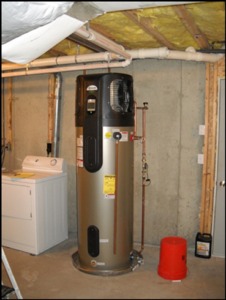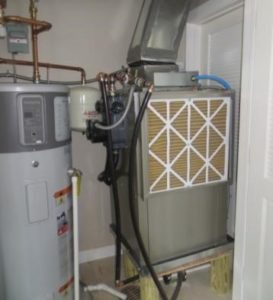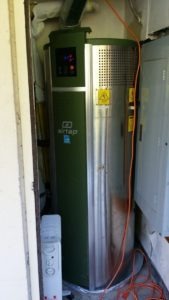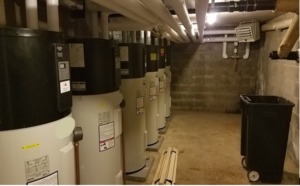

Blog
|
During the winter, a home’s space heating system probably needs to work harder to make up for the HPWH. In the summer, the HPWH provides a bit of extra cooling and dehumidification. We put together some guidelines a few years ago on how to get the most from these systems in single family homes.

In Electrify Everything? Part 1 that I wrote several months ago, I mentioned that integrated tank heat pump water heaters (HPWHs) can work well in single family homes — even in colder climates. For example, we see quite a few installed successfully in basements in the Northeast. These devices remove heat from the surrounding air, so there needs to be enough heat in the basement air for them to work effectively. During the winter, a home’s space heating system probably needs to work harder to make up for the HPWH. In the summer, the HPWH provides a bit of extra cooling and dehumidification. We put together some guidelines a few years ago on how to get the most from these systems in single family homes.

Some places where I’ve seen problems:
But overall, HPWHs in single family basements can work effectively.
In multifamily buildings, I have yet to see a good application of integrated HPWHs. When installed in individual apartments, HPWHs remove heat from the space, which can result in comfort problems. When installed in an apartment closet, even with louvered doors, there simply is not enough heat in closet air for a HPWH to operate efficiently. Louvered doors definitely let the sound out, however. In the apartment below, an air handler and a HPWH were installed in a closet with a louvered door and the sound pressure in the nearby living space was recorded at over 50 dBa. We’ve often seen people switch these HPWHs to resistance mode to eliminate the noise.

Installing HPWHs in a closet outside of the apartment can solve the noise issue, but not the thermal issue. In the building below (in upstate New York), resistance tanks in exterior closets (i.e., accessed from the outdoors) were replaced with HPWHs. When it was discovered that there was not enough heat in the closet for the HPWHs to work, louvers were cut into the door (to the outdoors). This didn’t help, and in the winter it was a disaster. Portable resistance heaters were added; these didn’t help either and defeated the whole point of HPWHs. These HPWHs were ultimately removed and replaced with resistance tanks.

In the image below, six HPWHs were installed in a modest-sized mechanical room. While this isn’t a “closet,” there’s not nearly enough heat in the air of this room to supply a 25-unit building with hot water. Once again, resistance heaters were added (see the upper right – there’s also one behind the photographer). These heaters run all year (we saw them running frequently in August), and they entirely void the energy, cost, and carbon benefits of HPWHs.

Some of these HPWH problems are more severe in colder climates, and some are getting less severe as more versatile equipment becomes available. Ducting a HPWH (from the intake and/or exhaust) can also help in some situations, but it’s not a cure-all. To help address these concerns, Eversource Energy hired SWA to develop guidelines for how and when to incorporate integrated HPWHs into multifamily buildings in a colder climate.
Integrated HPWH technology and installation practices will continue to improve, but integrated HPWHs are not the only systems out there. Sanden has a HPWH that uses CO2 as a refrigerant and draws heat from outdoors. It’s designed for single family applications, but several can be installed in parallel for multifamily buildings. Several other manufacturers (e.g., Aermec, Colmac) have much larger air-water heat pump systems, but they still can have trouble in very cold weather.
Technology is changing quickly, so stay tuned. In the meantime, we encourage people to be very thoughtful about where and when they use HPWHs. Fuel-fired systems or even resistance are still the most practical choices for some applications.
Robb Aldrich